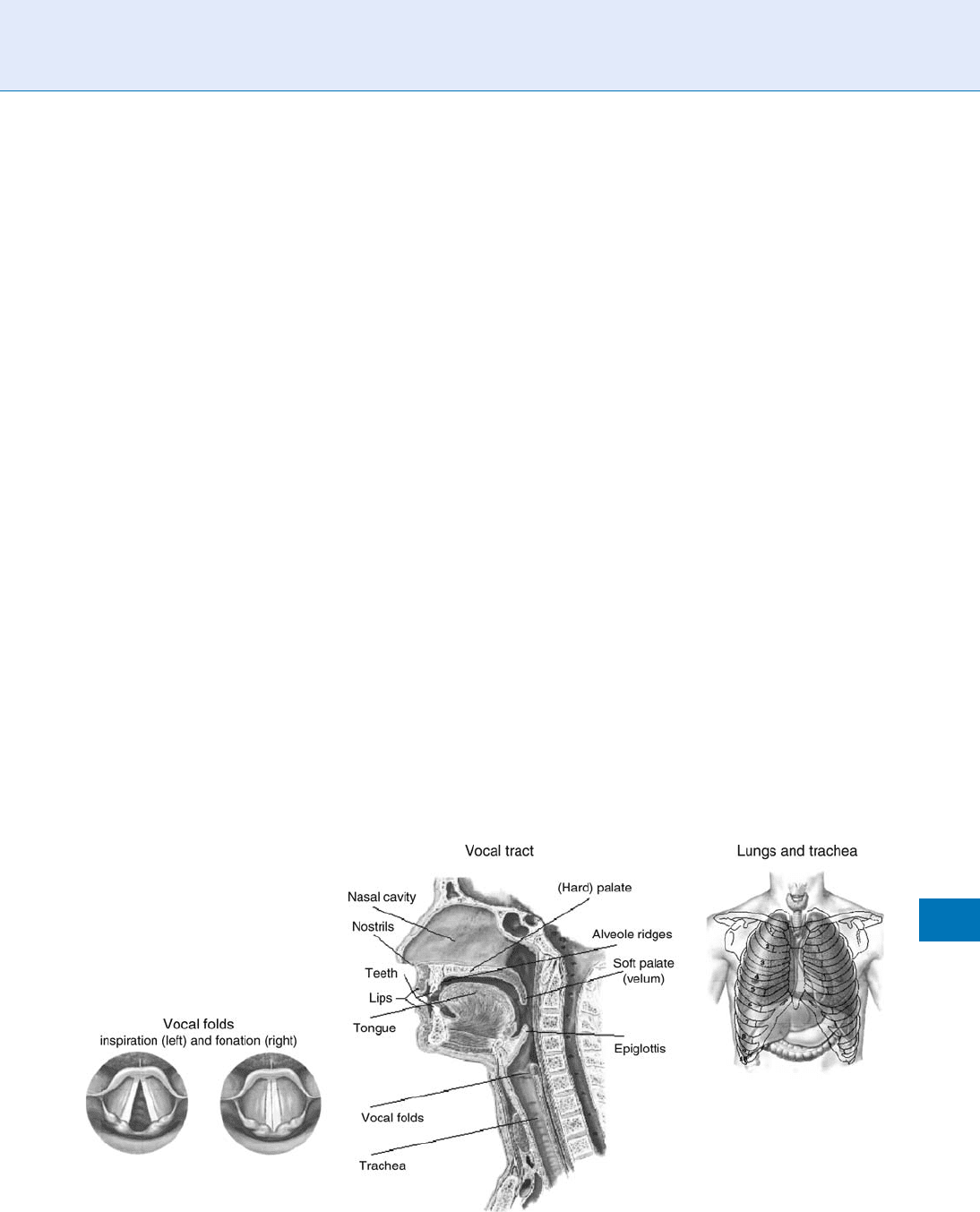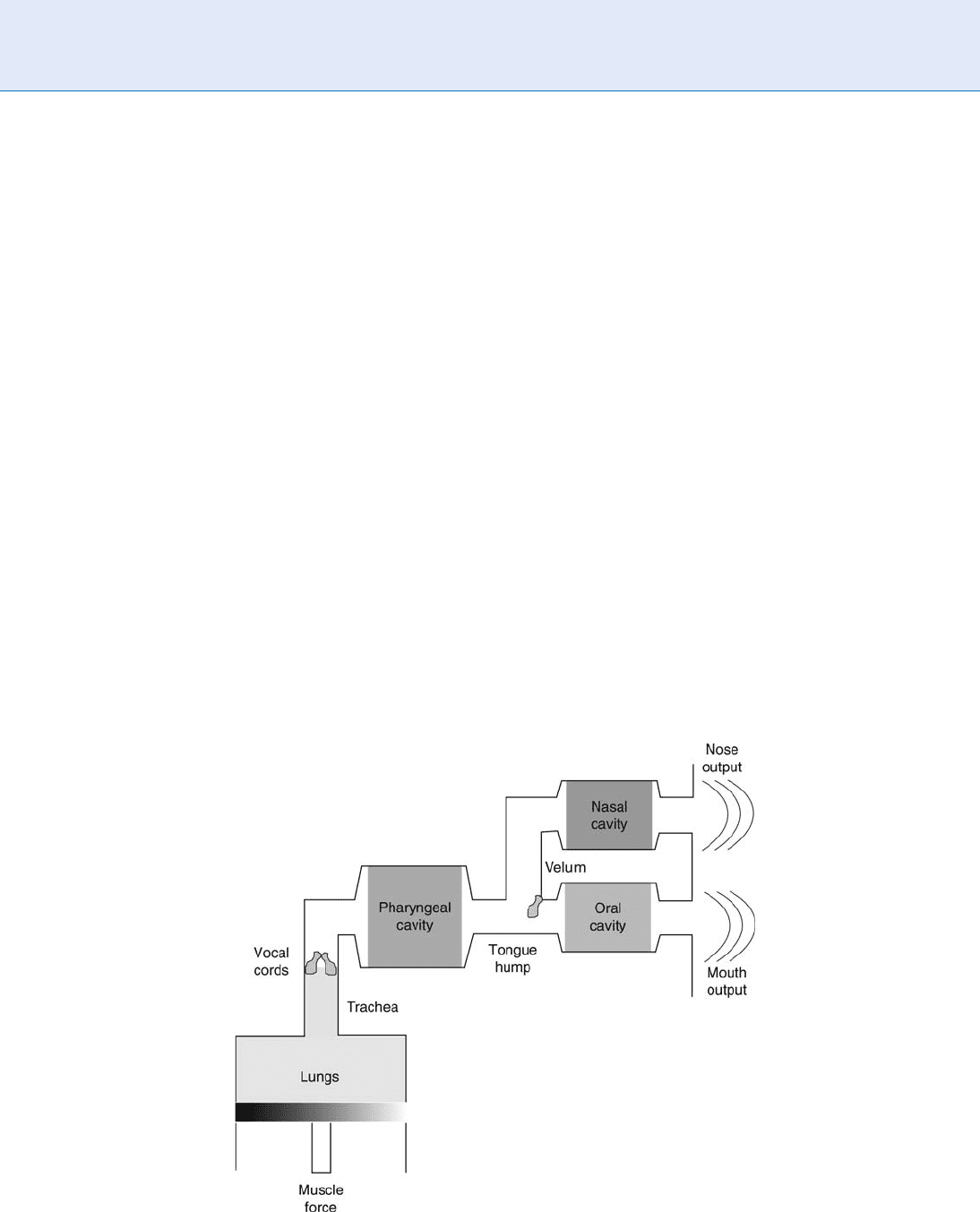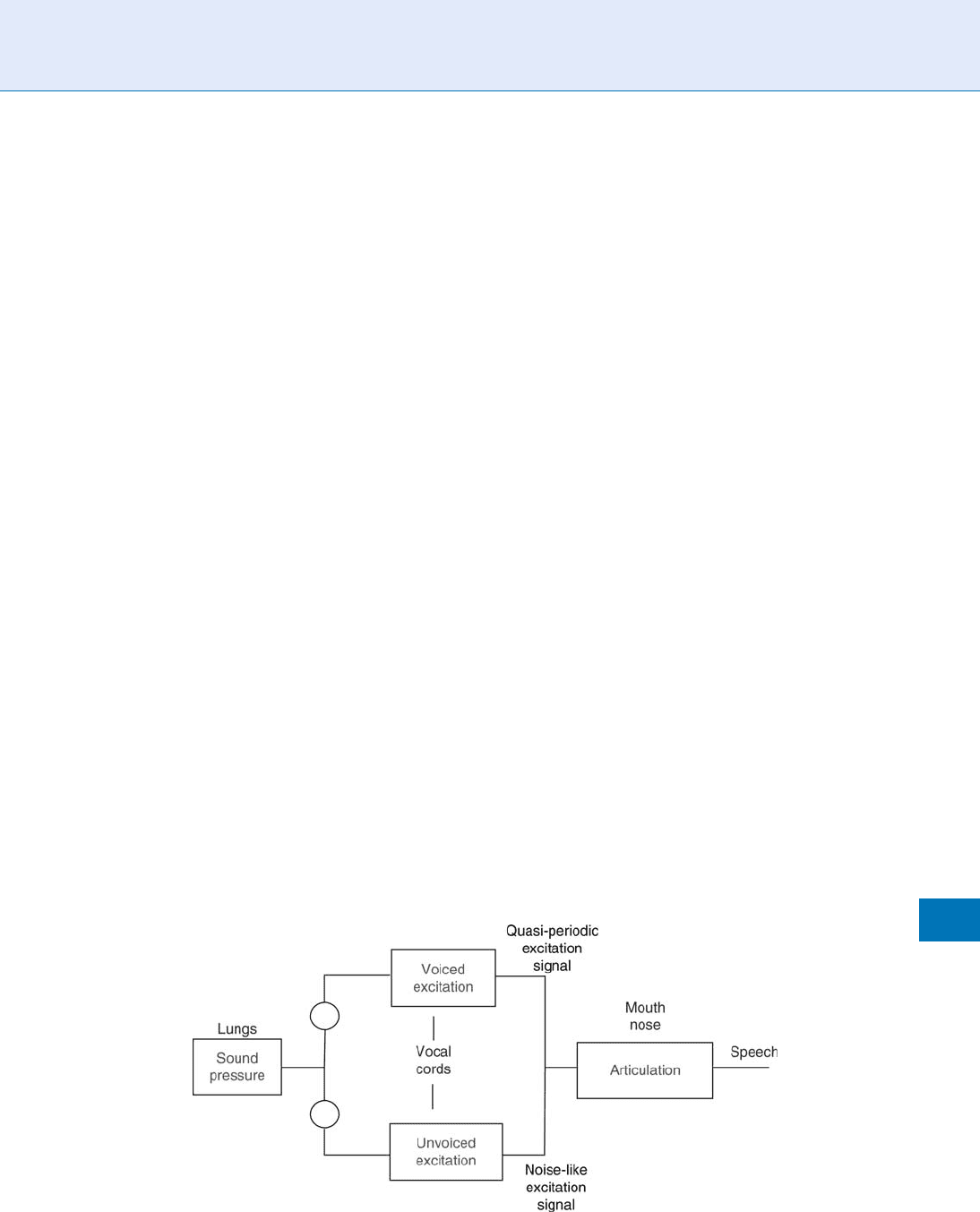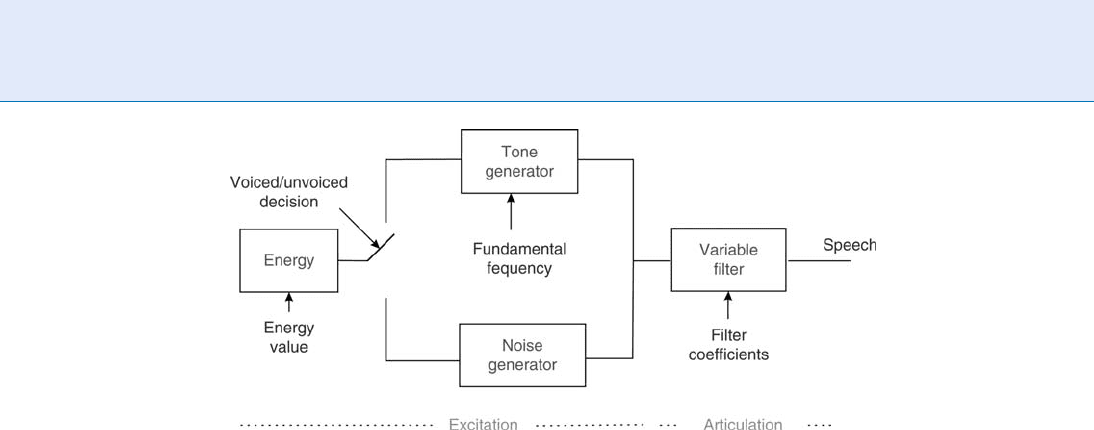Li S.Z., Jain A.K. (eds.) Encyclopedia of Biometrics
Подождите немного. Документ загружается.


Speech Parametrization
▶ Speech Analysis
Speech Processing
Speech processing is a technology that operates on the
stream of speech.
▶ Speaker Recognition, Standardization
Speech Production
LAURA DOCIO-FERNAND EZ,CARMEN GARCIA-MATEO
University of Vigo, Vigo, Spain
Synonyms
Speech system; Sound generation
Definition
Speech production is the process of uttering articulated
sounds or words, i.e., how humans generate meaningful
speech. It is a complex feedback process in which also
hearing, perception, and information processing in the
nervous system and the brain is involved.
Speaking is in essence the by-product of a necessar y
bodily process, the expulsion from the lungs of air
charged with carbon dioxide after it has fulfilled its
function in respiration. Most of the time one breathes
out silently; but it is possible, by contracting and relax-
ing the vocal tract to change the characteristics of the
air expelled from the lungs.
Introduction
Speech is one of the most natural forms of communi-
cation for human beings. Researchers in speech
technolog y are working on developing systems with
the ability to understand speech and speak with a
human being .
Human–computer interaction is a discipline con-
cerned with the design, evaluation, and implementation
of the most natural interactive computing systems for
human use [1]. Computers with this kind of ability are
gradually becoming a reality today, through the success
of speech synthesis, speech recognition, and other
related speech technologies. However, in order to give
them functions that are much closer to those of human
beings, one must learn more about the mechanisms by
which speech is produced and perceived, and develop
speech information processing technologies that make
use of these functions.
However, progress in advanced computer speech
interfaces is limited in part due to incomplete knowl-
edge of the physics of speech production. For compu-
ter generated speech output, this means limitations in
the naturalness and intelligibility of synthetic speech.
The generation of human speech involves a re-
markably complex process. In modeling the process
of human speech production one may recognize two
principal stages:
1. Formation in the mind of thoughts to be expressed
as well as the choice of words to be used. The
message is organized on the linguistic level and
structured grammatically and phonologically.
2. The string of phonemes is converted into a set of
continuous signals controlling the musculature of
the various articulators. This results in a highly
complex integrated movement sequence in which
generally participate all the articulators, the lips,
the tongue, the mandible, etc. Finally, the physical
interaction of the vibrating vocal cords and the
moving articulatory structure produces a continu-
ous acoustic signal perceived as speech.
Speech production is an activity embodied in a com-
plex physical system. It is produced by a cooperation of
lungs, glottis (with vocal cords), and articulation tract
(mouth and nose cavity). The speaker produces a
speech signal in the form of pressure waves that travel
from the speaker’s head to the listener’s ears. This
signal consists of variations in pressure as a function
of time and is usually measured directly in front of the
mouth, the primary sound source. The amplitude var-
iations correspond to deviations from atmospheric
pressure caused by traveling waves.
1290
S
Speech Parametrization

An audible speech signal is produced by moving
the vocal articulators to modify and ‘‘sculpt’’ the
source of sound energy in the vocal tract (e.g ., air
turbulence or vocal fold vibration). The signal is non-
stationary changing characteristics as the muscles of
the vocal tract contract and relax. Since spe aker wishes
to produce a
▶ sound sequence corresponding to the
message to be conveyed, most major vocal tract move-
ments have a voluntary basis. For each sound, there is a
positioning for each of the vocal tract articulators:
vocal cords, tongue, lips, teeth, velum, and jaw. Sounds
are typically divided into two broad classes: vowels,
which allow unrestricted airflow in the vocal tract;
and consonants, which restrict airflow at some point
and have a weaker intensity than vowels.
The most common sound generation sources are
quasi-periodic vibration of the vocal cords and tur bu-
lent noise generated by the passage of air through a
narrow constriction, usually in the oral cavity. More
rarely, sounds are generated by plosive release of air
(following the buildup of pressure behind an obstruc-
tion in the vocal tract), implosion (following the crea-
tion of a vacuum behind an obstruction in the vocal
tract), and clicks created by, the action of the tongue
pulling away from the roof of the mouth.
Depending on the type of excitation, i.e., sound
generation sources, two types of sounds are produced:
voiced and unvoiced sounds.
▶ Voiced sounds are pro-
duced by forcing air through the glottis or an op ening
between the vocal folds. Then the vocal folds vibrate,
they interrupt the air stream and produce a quasi-
periodic pressure wave that excite the vocal tract. An
example of voiced sound is the vowel ‘‘a’’ in cut, or ‘‘ee’’
in ‘‘beet.’’
▶ Unvoiced sounds are generated by form-
ing a constriction at some point along the vocal tract
and forcing air through the constriction to produce
turbulence. Vocal folds do not vibrate in this case. An
example of unvoiced sound is ‘‘s’’ as in ‘‘six.’’
The frequency at which vocal folds open and close
is called the fundamental frequency.
A major focus of speech production research is in
modeling articulatory–acoustic relationships of speech
sounds. Physically and physiologically based models
for speech acoustics are particularly important for
developing high-quality speech synthesis and low bit
rate (articulatory) coding. Significant progress has
been recently made towards developing improved
articulatory-acoustic models.
The Human Speech Production
Mechanism
Figure 1 shows an illustration of the human speech
production system. The gross anatomical components
of the systems are the lungs, trachea, larynx (orga n
of speech production), pharyngeal cavity (throat),
buccal cavity (mouth), and nasal cavity (nose).
Speech Production. Figure 1 Schematic view of human speech production mechanism.
Speech Production
S
1291
S

The pharyngeal and buccal cavities are usually grouped
and referred to as the vocal tract, and the nasal cavity is
often called nasal tract. Accordingly, the vocal tract
begins at the output of the larynx, and terminates at
the input of the lips. The nasal tract begins at the velum
and ends at the nostrils of the nose. There are many
other anatomical components that contribute to the
production of speech, such as the vocal folds (or
cords), tongue, lips, teeth, and jaw. These are referred
to as articulators and move to different positions in
order to produce various speech sounds. Due to the
physical constraints of the vocal tract, the positions of
the articulators can only change slowly with time and
individual realizations of a phone are strongly influ-
enced by previous and future phones in an utterance.
This phenomenon is known as coarticulation and is
important for both accurate speech analysis and natu-
ral speech production.
The speaker-specific characteristics of speech are
due to differences in physiological and behavio ral
aspects of the speech production system in humans.
The main physiological aspect of the human speech
production system is the vocal tract shape.
The process of human speech production can be
summarized as follows. While speaking, the air pushed
out from the lungs (the main energy source) travels
into the trachea, then up into the glottis, where it is
periodically interrupted by the movement of the vocal
cords. The tension of the vocal cords is adjusted by the
larynx so that the chords vibrate in an oscillatory
fashion, resulting in the production of voiced speech.
During unvoiced speech, constrictions within the vocal
tract (oral cavities – mouth, throat, etc.) force air
through the constriction to produce turbulence.
Speech production can be viewed as a filtering
operation (source-filter model of speech production
[2]) in which the three main cavities of the speech
production system (vocal and nasal tracts) comprise
the main acoustic filter. The filter is excited by the
organs below it (
▶ glottal excitation), and is loaded at
its main output by a radiation impedance due to the
lips (
▶ lip-radiatio n effect). The articulators, most of
which are associated with the filter itself, are used to
change the properties of the system, its form of excita-
tion, and its output loading over time. Figure 2 shows
this model. The source which excites the filter may be
either periodic, resulting in voiced speech, or noisy and
aperiodic, causing unvoicing speech.
The basic assumption of the model is that the source
signal produced at the glottal level is linearly filtered
Speech Production. Figure 2 Block diagram of human speech production system.
1292
S
Speech Production

through the vocal tract. The resulting sound is emit-
ted to the surrounding air through radiation loading
(lips). The model assumes that source and filter are
independent of each other. Although recent findings
show some interaction between the vocal tract and a
glottal source [3], Fant’s theor y of speech production
is still used as a framework for the descript ion of
the human voice.
An articulatory representation of the speech produc-
tion system has certain attractive properties which
might be exploited to help in modeling speech. Articu-
lation is the term used for all actions of the organs of the
vocal tract that effect modifications of the signal gener-
ated by the voice source. This modification results in
speech events which can be identified as vowels, con-
sonants or other phonological units of a language.
Speech articulators move relatively slowly and smoothly,
and their movements are continuous. The mouth can-
not jump instantaneously from one configuration to
a completely different one. Using speech production
knowledge could help to improve speech processing
methods by providing useful constraints. Suggested
applications include, for example, automatic speech
recognition, low bit-rate speech coding, speech analysis
and synthesis, and animated talking heads.
Modeling the Human Speech Production
System
Speech is transmitted between humans in the acoustic
domain, and fortunately, it can be easily measured and
recorded as acoustic representation. Underlyingly,
however, the acoustic speech signal is the product of
events in a speaker’s articulatory system, and there
has long been interest in ways to exploit the under-
lying articulator y information for speech techno-
logy. Increasingly detailed and sophisticated models
about how speech is generated in human speech
production system has been developed in the past
30 years [4].
The most relevant models of the speech production
mechanism belong to acoustic modeling, that is based
on the acoustic theory of speech production [5].
According to this theory, speech waveform is consid-
ered to be the output of a resonant network (namely
the vocal tract filter) that is excited by sound sources
placed at the glottis. The main sections of the speech
production mechanism, namely the voice source, vocal
tract, and radiation effects, are likely to be linearly
modeled in a noncoupled manner following a source-
filter arrangement. The assumption that the source and
the filter can be separately modeled probably holds for
most of the cases. However, this assumptio n is ques-
tionable for low frequencies, because the nonlinear
coupling may produce damping of the first formant.
It is also disputable for unvoiced speech (excitation is
due to turbulence originating at constrictions on the
vocal tract itself).
As described in the previous section, the human
speech production can be illustrated by a simple source-
filter model (Fig. 3). Here the lungs are replaced by a
DC source, the vocal cords by an impulse generator,
and the articulation tract by a linear filter system. A
noise generator produces the unvoiced excitation. In
practice, all sounds have a mixed excitation, which
Speech Production. Figure 3 A general model for speech production.
Speech Production
S
1293
S

means that the excitation consists of voiced and un-
voiced portions. Of course, the relation between these
portions varies strongly with the sound being generated.
In general, the source-filter model is related to
linear prediction. Based on this model, a further sim-
plification can be made ( Fig. 4). A ‘‘hard’’ switch which
only selects between voiced and unvoiced excitation is
used. The filter, representing the articulation tract, is a
simple recursive digital filter; its resonance behavior
(frequency response) is defined by a set of filter coeffi-
cients. Since the computation of the coefficients is based
on the mathematical optimization procedure of Linear
Prediction Coding, they are called Linear Prediction
Coding Coefficients or LPC coefficients and the com-
plete model is the so-called LPC Vocoder (Vocoder is a
concatenation of the terms ‘voice’ and ‘coding’) [6].
Speech can be modeled as the response of linear
time varying system with appropriate excitation. For
voiced speech, the excitation can be approximated by a
pulse train in which the pulses appear according to the
instantaneous pitch rate. If a single pitch period is
analyzed at a time, an analysis known as ‘‘pitch syn-
chronous analysis,’’ only one pulse occurs somewhere
in the period.
This model has a great advantage. Since the main
parameters of the speech production, namely the pitch
and the artic ulation characteristics, expressed by the
LPC coefficients, are directly accessible, the audible
voice characteristics can be widely influenced. Also
the number of filter coefficients can be varied to influ-
ence the sound char acteristics, above all, the formant
characteristics.
Articulatory models of speech production mechan-
isms aim at modeling the physical, anatomical, and
physiological functioning of the organs involved in
human voice production. In this approach, the system
is modeled instead of the signal or its acoustic charac-
teristics. Modeling the process at the articulatory level
can be expected to be simpler because the articulators
respond to muscular forces with predictable changes in
their position and rates of movement.
It is worth noting that, globally, the speech signal is
a nonstationary signal. Then, all the systems in such
speech production models should be time-varying,
with their parameters changing in accordance to the
sound to be produced. The classic source-filter linear
model is satisfactory only as a first approximation of
the overall nonlinear process of speech production,
and only for short time frames, on which the signal is
quasi-stationary.
The variability of the speech signal originates in
the specific dynamics of the articulatory apparatus.
It is well-known that the phon atory system is a time-
varying system, and consequently speech signal is
nonstationary. A large class of nonstationary and
nonlinear processes is involved in speech production.
Applications
To provide a compact computational model for speech
production that can be beneficial to a wide range of
areas in speech signal processing.
The speech production models which have been
derived can be applied in almost all fields of speech
processing like speech synthesis, speech analysis, speech
and speaker recognition, and also in speech coding.
Speech Production. Figure 4 A simplified discrete time model for speech production.
1294
S
Speech Production

Summary
Decades of research have gone into the technical and
quantitative understanding of human speech produc-
tion mechanisms.
This communication focuses on the human speech
production mechanism. Speech is produced through
the careful movement and positioning of the vocal-
tract articulators in response to an excitation signal
that may be periodic at the glottis, or noiselike due to
a major constriction along the vocal tract, or a
combination.
Related Entries
▶ Biometrics, Overview
▶ Speaker Features
▶ Speech Analysis
References
1. Hewett, T., Baecker, R., Card, S., Carey, T., Gasen, J., Mantei, M.,
Perlman, G., Strong, G., Verplank, W.: Chapter 2: Human–
computer interaction. In: B. Hefley (ed.) ACM SIGCHI
Curricula for Human–Computer Interaction. ACM, (2007)
2. Fant, G.: Acoustic Theory of Speech Production, 1st edn. Mou-
ton, The Hague (1960)
3. Fant, G.: Glottal flow: models and interaction. J. Phon. 14,
393–399 (1986)
4. Kent, R.D., Adams, S.G., Turner, G.S.: Models of speech produc-
tion. In: Principles of Experimental Phonetics, pp. 2–45. N.J.
Lass, Mosby (1996)
5. Burrows, T.L.: Speech Processing with Linear and Neural Net-
work Models (1996)
6. Deller, J.R., Proakis, j.G., Hansen, J.H.L.: Discrete-Time Proces-
sing of Speech Signals, 1st edn. Macmillan, New York (1993)
Speech Recognition
Speech recognition is a non-biometric technology that
enables a machine to recognize the words a speaker
speaks.
▶ Remote Authentication
▶ Speaker Recognition, Standardization
Speech Spectral Envelope
The speech spectral envelope is referred as an approxi-
mation to the frequency response of the vocal tract
obtained from the speech signal. The speech spectral
envelope contains the most discriminative information
available in speech to distinguish phonemes and
speakers.
▶ Speech Analysis
Speech Synthesis
▶ Voice Sample Synthesis
Speech System
▶ Speech Production
Speed
▶ Signature Recognition
SPME
SPME is a simple, solvent-free headspace extrac-
tion technique in which volatile and semi-volatile
organic compounds adhere to the fiber either by
adsorption or absorption depending on the fiber
type. The fiber itself is constructed out of a station-
ary phase-like material which is selected for use
based on the functionality of the substances present
for extraction.
▶ Odor Biometrics
SPME
S
1295
S

Spoofing
Spoofing entails the presentation of an artifact
designed to imitate a legitimate biometric so as to
defeat or circumvent a biometric system or process.
▶ Anti-spoofing
▶ Fraud Reduction, Overview
Spoofing Countermeasures
▶ Liveness Detection: Iris
Spoof-resistance
▶ Liveness Detection: Iris
Stand Off
The distance between a biometric capture device and
the subject from whom the biometric is captured.
▶ Iris Device
▶ Iris on the Move
Statistical Models
▶ Deformable Models
Statistical Signal Processing
▶ Fusion, Decision-Level
Steganography
Hiding a secret message within a larger, typically unre-
lated cover message suc h that unintended recipients do
not suspect the presence of the hidden message. In
steganography, the cover message ser ves only as a
mechanism to transport the secret me ssage; it may be
discarded or destroyed after the secret message has
been extracted and communicated to the intended
recipient. An example might include a spy posing as
a tourist sending government secrets via images of
tourist venues.
▶ Iris Digital Watermarking
Strain Gauge
Strain gauge is a device used to measure deformation
(strain) of an object. It is a sensor whose resistance
varies with applied force; it converts force, pressure,
tension, weig ht, etc., into a change in electrical resis-
tance which can then be measured.
▶ Digitizing Table t
Stream of Speech
Stream of speech is the flow of sounds, words, and
utterances produced by a human speaker.
▶ Speaker Recognition Standardization
Strength of Voice Evidence
The strength of the forensic evidence of voice is the
result of the interpretation of the evidence, expressed
in terms of the likelihood ratio of two alternative
hypotheses: H
0
– the suspecte d speaker is the source
of the questioned recording, H
1
– the speaker at the
1296
S
Spoofing

origin of the questioned recording is not the suspected
speaker.
▶ Voice, Forensic Evidence of
Stroke
Single movement of a pen during the signing process.
The number of strokes and the stroke order are very
important features for on-line signature verification.
Strokes are in general delimited by a change in the pen
up/down status.
▶ Signature Recognition
Structural and Functional Anatomy
▶ Anatomy of Face
Structural Model
Describes the fundamental structures that interlink
and constitute a body and specifies their constraints:
e.g., torso and upper leg are linked by the hip, upper
leg and lower leg are linked by the knee, and the knee
constrains the degree of freedom of the lower leg.
Therefore, it also defines the dependency of one body
segment to another. Structural model is normally used
together with a motion model to guide feature (of
motion) extraction process. It may also consist of
information such as length, thickness, area, or volume.
▶ Gait Recognition, Model-Based
Structural Risk
The error associated with the nature of the classifier.
Structural risk minimization tunes the complexity
of the classification function in order to optimize
the generalization. The true risk combines structural
risk with empirical risk, which is dependent on the
training set.
▶ Support Vector Machine
Structure Tensor Field
The matrix field obtained by outer products of the
gradients.
▶ Fingerprint Features
Structure-from-Motion
The process of recovering the three-dimensional struc-
ture of an object by the analysis of subsequent two-
dimensional images of the object in motion. Although
this term most commonly refers to the recovery of the
structure of a rigid object (i.e., the distances between
all points on the object remain constant), it still applies
to piecewise rigid objects such as the human body
where only some subsets of points remain rigid.
▶ Psychology of Gait and Action Recognition
Subject Interaction Time
▶ Operational Times
Super-Resolution
The techniques that form an enhanced-resolution
image by fusing together multiple low-resolution
Super-Resolution
S
1297
S

and/or learning from high-resolution training images
are known as super-resolution. Super-resolution can
be performed in either frequency or spatial domain.
▶ Face Sample Quality
Super-Resolution for Iris
▶ Iris Super-Resolution
Supervised
Supervised are the class labels of all data w hich are
known. Algorithms are designed for separation of
data of different classes by additionally using labeled
information.
▶ Linear Dimension Reduction
Supervised Learning
JONG KYOU NG KIM,KYE-HYEON KIM,SEUNGJIN CHOI
Department of Computer Science, Pohang University
of Science and Technology, Korea
Synonyms
Classification
Introduction
Supervised learning is to find a model for an unknown
target function, using a given set of training examples –
pairs of a data point and a target function value. The
fundamental assumption of learning by examples is
that similar data points tend to have similar function
values. In this chapter, learning tasks are focused
on classification, in which the aim is to assign each
data point to one of a finite number of function
values, called class labels. Then, the assumption can
be restated that a group of similar data points form a
meaningful pattern , which corresponds to the same
class label.
Biometric recognition systems require two different
classification problems of verification and identifica-
tion, depending on the application context [1]. In
the verification problems, we need to verify a claimed
identity by comparing an input feature vector extrac-
ted from the biometric data with the corresponding
template feature set. The verification problem can be
restated as binary classification, in which the learned
classifier takes the feature vector as an input and deter-
mines whether the claimed identity is true or false.
The goal of identification problems, however, is to rec-
ognize a person’s identity by searching templates
corresponding to all the users enrolled in the biometric
database. The identification problem may be stated
as classification with K þ 1 classes fC
1
; ...; C
K
; C
Kþ1
g,
where K is the number of the users enrolled in the
system and the last class C
Kþ1
indicates the unidenti-
fied user.
A variety of approaches for classification can be
grouped into parametric and nonparametric, based
on the assumptions about class-conditional densities
[2]. If the class-conditional densities are specified with
a functional form of distributions, which are charac-
terized completely with a finite number of parameters,
we have a parametric method for classification. In
contrast, if we model the class-conditional densities
without any assumptions regarding the functional
form of the underlying distribution, non-parametric
algorithms are derived. The methods that directly con-
struct the decision boundaries without referring to the
class-conditional densities are also considered as non-
parametric approaches.
Parametric Approach
Suppose we have a D-dimensional real-valued feature
vector x ¼ (x
1
,...x
D
)
T
. The goal of classification is to
predict the class label for a new value of x given a training
set of D. According to Bayesian decision theory, an
optimal decision boundary can be obtained from
1298
S
Super-Resolution for Iris

posterior probabilities for classes. Using Bayes’ theorem,
the posterior probabilities pðC
k
jxÞ can be written as
pðC
k
jxÞ¼
pðxjC
k
ÞpðC
k
Þ
P
j
pðxjC
j
ÞpðC
j
Þ
¼
expða
k
Þ
P
j
expða
j
Þ
; ð 1Þ
where pðxjC
k
Þ is the class-conditional density repre-
senting the probability of a feature vector x given class
C
k
, pðC
k
Þ is the prior probability of class C
k
, and a
k
is
defined by
a
k
¼ ln pðxjC
k
ÞpðC
k
Þ: ð2Þ
In parametric approaches to classification, we directly
model the class-conditional density with a parametric
form of probability distribution (e.g., multivariate
Gaussian). Many parametric methods for classification
have been proposed based on different assumptions for
pðxjC
k
Þ [3, 4, 5] (see Table 1):
1. Linear discriminant analysis (LDA) uses Gaussian
distributions Nðm
k
; S
k
Þ for the class-conditional
densities with a common covariance matrix S
k
¼S.
2. Quadratic discriminant analysis (QDA) also uses
Gaussian distributions and does not assume equal
covariance matrices.
3. In a naive Bayes classifier, we assume that the dis-
tributions of the feature values x
1
,...x
D
are condi-
tionally independent given the class label, pðxjC
k
Þ¼
Q
D
i¼1
pðx
i
jC
k
Þ. In parametric approach, the one-
dimensional densities pðx
i
jC
k
Þ are usually Gaussian
for continuous features or multinomial for discrete
features.
The parameters of each class-conditional densities can
be estimated from a training set D with a maximum
likelihood approach.
Linear Discriminant Analysis
We assume that all class-conditional densities pðxjC
k
Þ
are Gaussian with the same covariance matrix S. Then
the density for class C
k
is given by
pðxjC
k
Þ¼
1
ð2pÞ
D=2
1
jSj
1=2
exp
1
2
ðx m
k
Þ
>
S
1
ðx m
k
Þ
:
ð3Þ
From (1), we have
a
k
ðxÞ¼w
>
k
x þw
k0
; ð4Þ
where
w
k
¼ S
1
m
k
: ð5Þ
w
k0
¼
1
2
m
>
k
S
1
m
k
þ ln pðC
k
Þ: ð6Þ
We see that the equal covariance matrices make a
k
(x)
to be linear in x, and the resulting decision boundaries
will also be linear. As a special case of LDA, the nearest-
neighbor classifier can be obtained, when S¼s
2
I. If the
prior probabilities pðC
k
Þ are equal, we assign a feature
vector x to the class C
k
with the minimum Euclidean
distance jjx m
k
jj
2
, which is equivalent to the opti-
mum decision rule based on the maximum posterior
probability. Anoth er extension of LDA could be
obtained by allowing for mixtures of Gaussians for
the class-conditional densities instead of the single
Gaussian. Mixture discriminant analysis (MDA) [6]
incorporates the Gaussian mixture distribution for
the class-conditional densities to provide a richer
class of density models than the single Gaussian.
The class-conditional density for class C
k
has the
form of the Gaussian mixture model, pðxjC
k
Þ¼
P
R
r¼1
p
kr
Nðxjm
k
; SÞ, where the mixing coefficients
p
kr
must satisfy p
kr
0 together with
P
R
r¼1
p
kr
¼ 1.
In this model, the same covariance matrix S is used
within and between classes. The Gaussian mixture
model allows for more complex decision boundaries
although it does not guarantee the global optimum of
maximum likelihood estimates.
Quadratic Discriminant Analysis
If the covariance matrices S
k
are not assumed to be
equal, then we get quadratic functions of x for a
k
(x)
a
k
ðxÞ¼
1
2
ðx m
k
Þ
>
S
1
k
ðx m
k
Þ
1
2
ln jS
k
jþln pðC
k
Þ:
ð7Þ
Supervised Learning. Table 1 Comparison among
parametric methods for classification
Method pðxjC
k
Þ
Number of
parameters
Decision
boundary
LDA Nðm
k
; SÞ (K1)
(Dþ1)
Linear
QDA Nðm
k
; S
k
Þ (K1)
(D(Dþ3)∕
2þ1)
Quadratic
Naive Bayes
classifier with
multinomial
distributions
Q
D
i¼1
pðx
i
jC
k
Þ (K1)
(Dþ1)
Linear
Supervised Learning
S
1299
S
